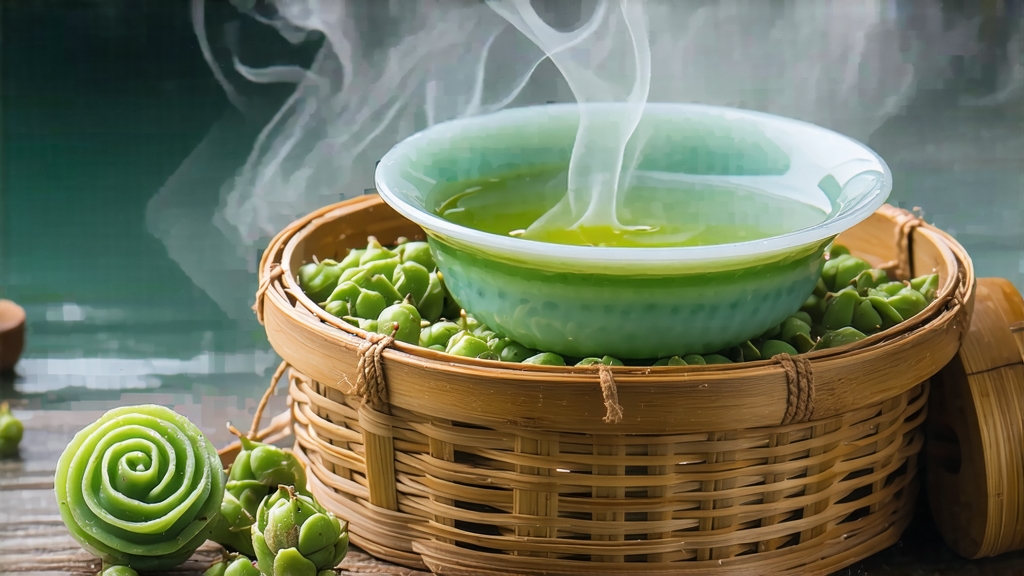
Among the jade-colored constellation of Chinese green teas, none carries the romance of early spring quite like Biluochun. Its name—literally “Green Snail of Spring”—evokes the tight spiral of each downy bud, a shape said to resemble the whorled shell of a freshwater snail found along the banks of Lake Tai. Yet the tea is also known by an older, more poetic title, Xia Sha Ren Xiang, “Startling Fragrance,” a legend born in the Kangxi era when the Qing emperor visited the lake and was so overcome by the perfume drifting from a servant’s tea that he immediately asked its origin. Thus an imperial brush renamed the humble local tea, elevating it to the pantheon of China’s Ten Famous Teas.
Biluochun’s terroir is inseparable from water, mist, and rock. The Dongting Dongshan and Xishan peninsulas rise from Taihu like dragon backs, their granite soils laced with quartz and feldspar that drain quickly yet retain faint moisture. Plum, apricot, and loquat trees are interplanted among the tea bushes, their roots sharing the same porous earth and their blossoms exchanging pollen with the tea flowers. When the first spring mists roll off the lake, they settle on these fruit trees and drip, perfumed, onto the tea shrubs below. The result is a subtle osmosis: the leaf stores not only the minerality of granite but also the lactone sweetness of neighboring fruit, a trait no other Chinese green tea replicates.
Although all Biluochun comes from Suzhou prefecture, connoisseurs recognize two micro-appellations. “Dongshan” leaf, grown on the eastern peninsula, faces morning sun and lake humidity; it tends toward a creamier body and orchid nose. “Xishan” leaf, on the western ridge, catches the afternoon light reflected off rippling water, yielding a brighter cup with sharper snap-pea top notes. Within each hill zone, elevation further refines character: bushes above 200 m ripen ten days later, concentrating amino acids and producing the elusive “umami-sweet” finish prized by gourmets.
Plucking begins when the air temperature hovers between 12 °C and 15 °C, usually the day after Qingming when the bud reaches what locals call “one flag, one leaf”—a tiny unfurled leaflet hugging the shoot tip. Pickers pinch, never pull, so the stem’s cortex remains intact and green. A seasoned hand can gather 600 grams of fresh leaf in an hour, yet that same quantity shrinks to a mere 100 grams after the long craft of making.
Withering is brief: the baskets of buds rest no more than thirty minutes beneath gauze curtains in a drafty pavilion, just long enough for the lake breeze to evaporate surface moisture. The true transformation occurs in the wok, a shallow basin of cast iron heated to 180 °C. The master tosses the leaves with bamboo whisk in a motion called tui, shan, cuo—push, fan, twist. Each gesture has acoustic cues: the crackle of water vapor escaping the cuticle, the soft slap of leaf against iron, the final hush when temperature drops to 80 °C and the spiral sets. In four minutes the leaf turns from jade to emerald, its downy trichomes now visible like frost on a spring morning. A second, cooler firing follows to fix the shape and reduce moisture to 5 percent. No rolling machines touch Biluochun; every curl is born from wrist and wok, a kinetic dialogue between fire and flesh.
To brew, choose glass tall enough to watch the dance. Three grams—about forty buds—are plenty for 150 ml of water cooled to 75 °C. Pour along the wall so the spirals sink slowly, then rise in a slow-motion pirouette. Within thirty seconds the liquor turns the color of pale chrysoprase, releasing an aroma that moves through stages: first white peach, then fresh lychee, finally a fleeting hint of narcissus. The first infusion should be sipped at 60 °C, when the amino acids coat the tongue like silk. Second infusion at 70 °C lengthens the fruit note into a ripe apricot sweetness. A third, flash-steeped at 80 °C, offers a mineral snap reminiscent of wet granite. Beyond three steeps the leaf gracefully retires,